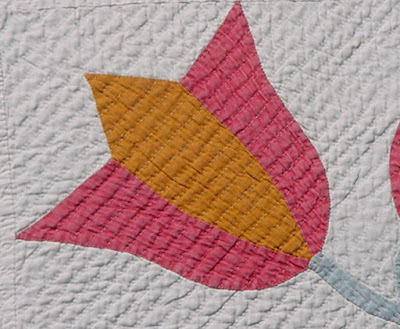Early quilt with variations of what is called Tea Cup or Wine Glass quilting
Last week we talked about feather quilting as a good traditional choice for reproduction quilts. That would be custom quilting, which costs more than what the long-armers call edge-to-edge---All-over designs.
Early quilts with an intersecting circle pattern
On point
On the Straight
Mavis Fitzrandolph in her book on British quilts showed these as filler patterns but they are also seen as over-all designs. Because they are curved, the patterns are easily done with long-arm templates. Curves are probably a good edge-to-edge design for a reproduction quilt.
Shell quilting. We do not call it "Mother of Thousands"over here.
Long arm rulers and templates
I know nothing about long arm quilting but they
have their own tools that seem to work quite well.
Marie Webster also showed the scallop or shell design, which
evolved into the very American fans (sometimes call Baptist Fans,
although the Methodist church ladies and the Presbyterians did them too.)
Triple line fans. Fans were often done free hand.
The quilters at A Better Quilt do fans as edge-to-edge quilting.
The most common kind of hand quilting for filler or all-over utility quilting
was parallel lines, sometimes doubled, sometimes tripled.
Some of Becky Brown's gorgeous hand-quilted
patterns on her Quintal Vases,
which won her a first prize in hand quilting at an AQS contest.
And then there are grids on the straight or on point.
The double grid is called plaid
and the horizontal crossed by diagonals is hanging diamonds.
But the pattern of close parallel lines now called matchstick quilting is a popular style, particularly with people quilting on a regular sewing machine. It's also a great hand quilting design as it is mindless and you mark it with masking tape.
Here's a period look you may want to ignore. 19th-century quilters very often quilted right over the applique.
Echo quilting and self quilting are probably a better choice.
Self-quilting or quilting in the piece goes around the applique patches, puffing them up.Echo quilting is the filler, the curved lines following the patchwork.
Self quilting with a grid filler
Echo quilting a 1/4 inch apart
How much time or money do you have?























8 comments:
Not enough of either time or money! LOL
I was going to say the same thing as Lori! Never enough time or money! I wanted to ask you Barbara, around what time period was the first quilt quilted by a machine?
Becky's quilt is amazing!!
I appreciate this information as I enjoy both long arm quilting and making quilts. Our guild receives quilts from our members that they have made but don’t want and we get them finished to give away. Some are made in traditional styles and this will help me decide how to quilt them as welll as my own. Thanks so much!
What about patience, especially if hand quilting? I've been working on hand quilting a quilt for ?? years now, I'm not quite half done. Although, I'm outlining the printed design on the fabric, with lots of twists and turns. My patience runs out before my time to work on it at night in front of the TV does. Maybe these filers go faster and would have been a better choice? I agree that applique looks much better when it's left out of the background fill.
I'm going to guess that the first machine quilting probably was being done not long after sewing machines were available. Or at least it was being experimented with. And probably being pooh-poohed by the quilting police of the time. I wonder... if any of the early machine quilted quilts survived, was it presumed to have been quilted later than it was? Or was early machine quilting done on utility quilts and used up and discarded?
I love this series on the quilting. I am always as interested in the quilting as any other aspect of quiltmaking but don't often see it featured.
In my reading, when early sewing machines came out women were PROUD to have one, and would show off that they had one by machine quilting their quilts. Old photographs of settlers with their Soddy home behind them shows the family outside, with her sewing machine and often a bird in a cage. It got lonely out in the Midwest on the plains. No trees, no neighbors in sight, no hills or mountains... so they sewed and listened to their bird sing.
your quilts are beautiful. I started a quilting class this morning and am excited to learn about the art of quilting. Thanks for sharing.
Post a Comment